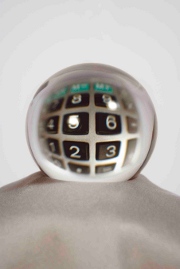A magazine where the digital world meets the real world.
On the web
- Home
- Browse by date
- Browse by topic
- Enter the maze
- Follow our blog
- Follow us on Twitter
- Resources for teachers
- Subscribe
In print
What is cs4fn?
- About us
- Contact us
- Partners
- Privacy and cookies
- Copyright and contributions
- Links to other fun sites
- Complete our questionnaire, give us feedback
Search:
How to fake a super brain
So how has this illusion of super maths power been possible?

Well it's all down to the genius of the 6th century Indian mathematician Virahanka and the 13th century Italian mathematician Leonardo Pisano. Leonardo Pisano is better known by his nickname Fibonacci, and that is where the term "Fibonacci sequence" comes from.
Adding the first and second numbers to get the third number in the sequence then adding the second and third numbers to get the fourth number, and so on creates a Fibonacci sequence, and these number sequences have some very special properties. Let's look at the trick. How can you do the sum so quickly? Well the sum of all ten numbers every time is just eleven times the fourth number from the bottom, and multiplying by 11 is easy even without a calculator - you just multiply by 10 and add the number back again! So 11x248 is 2480+248 ... 2728 and that's the trick! But of course what's important with any trick is that you really know for sure it will always work and I'm not just making it up. You wouldn't want it to go wrong in front of an audience would you!
Prove it then!
OK, so I'll prove it! What could possibly go wrong? Well the only free choices are the starting numbers (16 and 21 here), so you can check that my claim of 11x the fourth number from the bottom of a list of 10 is correct, but we've seen that's true for those numbers. What happens if the person picks other numbers? Well we could try checking all possible number combinations, but hey, you have a life, so lets use some computational thinking here.
Rather than use specific numbers let's get all abstract and mathematical. Lets call the first two numbers A and B. That way they can be anything! So lets see how the sequence builds up with these. It's simply a case of adding the A's and B's, so for example the third term is the sum of A and B. That's easy it's A+B, the fourth is B+ (A+B) = A+2B, and so on, writing it out in full we have:
A
B
A + B
A + 2B
2A + 3B
3A + 5B
5A + 8B
8A + 13B
13A + 21B
21A + 34B
---------
55A + 88B
So we now know that the sum of 10 terms, starting with A and B (whatever they actually are) is 55A+88B, but look at the value fourth number up from the bottom. It's 5A + 8B, and what do we get if we multiply 5A + 8B by 11? That's right it is 55A + 88B, the total sum! So the trick works because there is something mathematically special about adding up exactly ten numbers from a Fibonacci sequence and we now know for sure that it will work for any two starting values A and B. Sorted!


